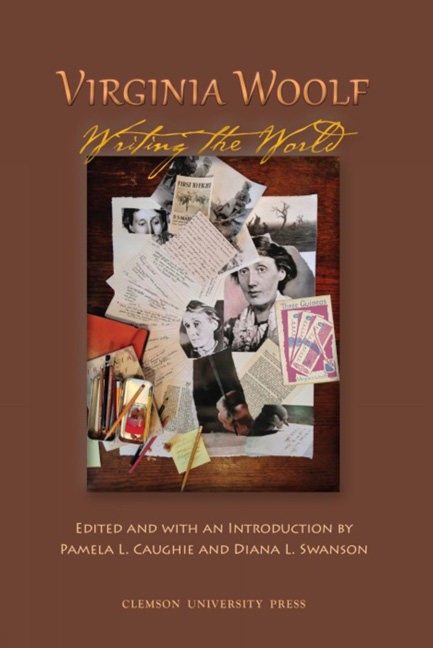Book contents
- Frontmatter
- Table of Contents
- Introduction
- Acknowledgmen
- Abbreviation
- WAR AND PEACE
- Roundtable: Woolf and Violence
- Intersections: Surveillance, Propaganda, and Just War
- Modernism and Memorials: Virginia Woolf and Christopher Isherwood
- Taking Up Her Pen for World Peace: Virginia Woolf, Feminist Pacifist. Or Not?
- The Sex War and the Great War: Woolf's Late Victorian Inheritance in Three Guineas
- Sky Haunting: The British Motor-Car Industry and the World Wars
- The 1914 “Expurgated Chunk”: The Great War in and out of The Years
- “beauty, simplicity and peace”: Faithful Pacifism, Activist Writing, and The Years
- Virginia Woolf, Katharine Burdekin, and Britain's Cosmopolitan Musical Culture
- Death in the Air: Virginia Woolf and Sylvia Townsend Warner in World War II
- WORLD WRITER(S)
- ANIMAL AND NATURAL WORLD
- WRITING AND WORLDMAKING
- Notes on Contributors
- Conference Program
- Appendix: Virginia Woolf Conference Exhibit Items, Newberry Library
Sky Haunting: The British Motor-Car Industry and the World Wars
from WAR AND PEACE
- Frontmatter
- Table of Contents
- Introduction
- Acknowledgmen
- Abbreviation
- WAR AND PEACE
- Roundtable: Woolf and Violence
- Intersections: Surveillance, Propaganda, and Just War
- Modernism and Memorials: Virginia Woolf and Christopher Isherwood
- Taking Up Her Pen for World Peace: Virginia Woolf, Feminist Pacifist. Or Not?
- The Sex War and the Great War: Woolf's Late Victorian Inheritance in Three Guineas
- Sky Haunting: The British Motor-Car Industry and the World Wars
- The 1914 “Expurgated Chunk”: The Great War in and out of The Years
- “beauty, simplicity and peace”: Faithful Pacifism, Activist Writing, and The Years
- Virginia Woolf, Katharine Burdekin, and Britain's Cosmopolitan Musical Culture
- Death in the Air: Virginia Woolf and Sylvia Townsend Warner in World War II
- WORLD WRITER(S)
- ANIMAL AND NATURAL WORLD
- WRITING AND WORLDMAKING
- Notes on Contributors
- Conference Program
- Appendix: Virginia Woolf Conference Exhibit Items, Newberry Library
Summary
Virginia and Leonard Woolf bought their first automobile in the summer of 1927. It was a used Singer, and while Woolf expressed her enthusiasm for motoring in letter after letter, the car itself was not always reliable. “My God, how you would have laughed yesterday!” she wrote to Vita Sackville-West on August 3: “Off for our first drive in the Singer: the bloody thing wouldn't start. The accelerator died like a duck—starter jammed. All the village came to watch—Leonard almost sobbed with rage. At last we had to bicycle in and fetch a man from Lewes. He said it was the magnetos—would you have known that? Should we have known? Another attempt today, we are bitter and sullen and determined. We think of nothing else. Leonard will shoot himself if it dont start again” (L 3 407). Though the motor-car in Mrs. Dalloway (1925) has been pulled off to the side of Bond Street with a punctured tire, the Singer's starter mechanism places Woolf in a similarly stalled position; and while she exaggerates her frustration to typically comical ends, the violence of the tone and imagery connects the breakdown to its equally disruptive twin: the accident.
The Woolfs had a few of those too, though of a minor sort. Leonard backed their Singer into gate posts, hedges, and—after a visit to Charleston—their own garage: “we knocked a bit off the car getting it into the shed” (L 3 405). Woolf describes her own driving practice to Janet Case as “wobbling round and round Windmill Hill, every day, trying to avoid dogs and children” (L 3 403) and notes in a letter to Ethel Sands that she has “driven from the Embankment to the Marble Arch and only knocked one boy very gently off his bicycle” (L 3 400). Though she states to Sands that she “would rather have a gift for motoring than anything,” it did not seem forthcoming, at least according to that year's Charleston Bulletin:
The less said about July the better.
Mrs. Bell drove from Hyde Pk-Corner to Marble Arch.
Mr. Woolf drove from Marble Arch to Hyde Park Corner.
Mrs. Woolf knocked a boy of [sic] his bicycle.
Mrs. Bell killed a cat.
The less said the better. (Woolf and Bell 113)
- Type
- Chapter
- Information
- Virginia Woolf: Writing the World , pp. 49 - 54Publisher: Liverpool University PressPrint publication year: 2015



